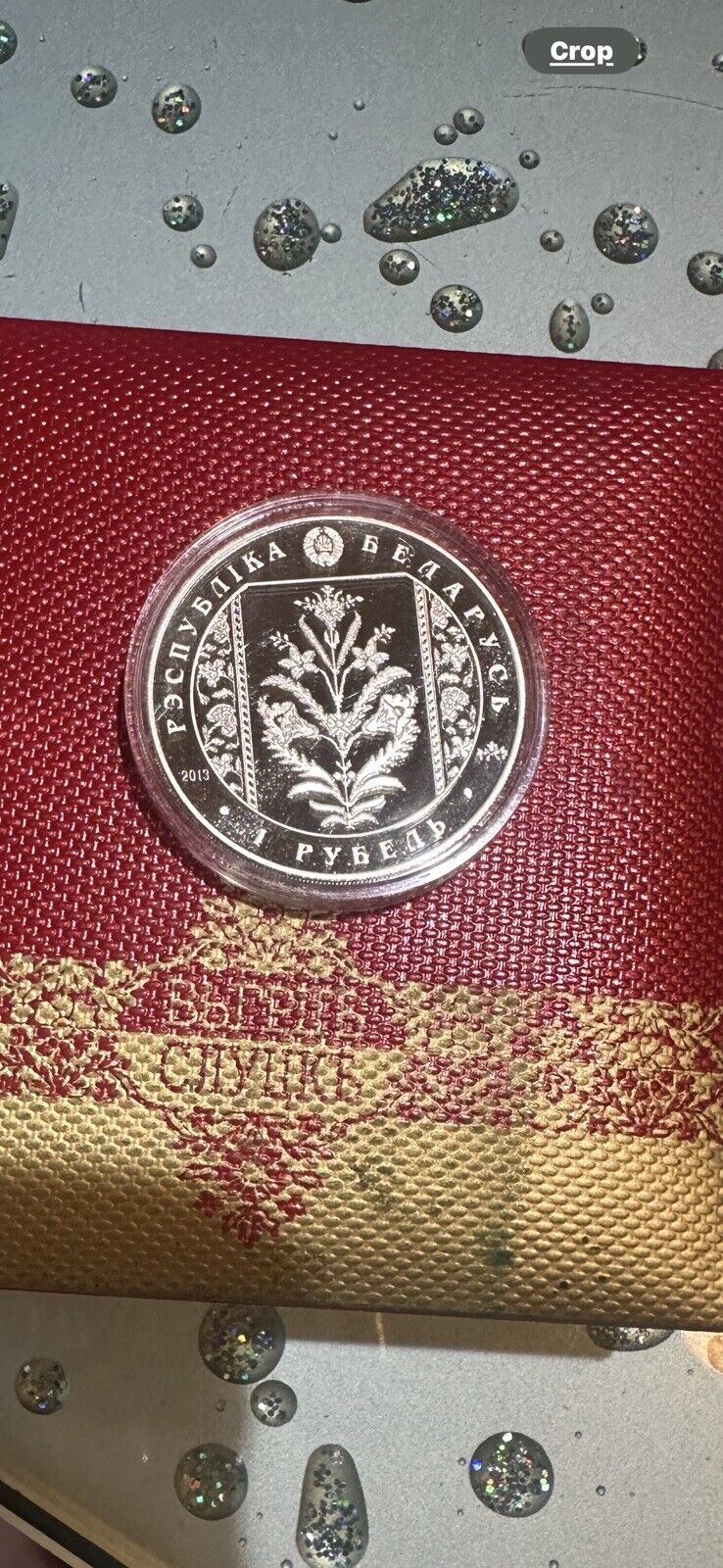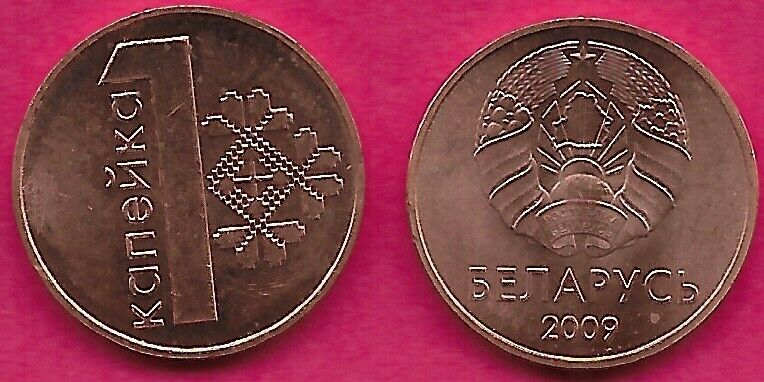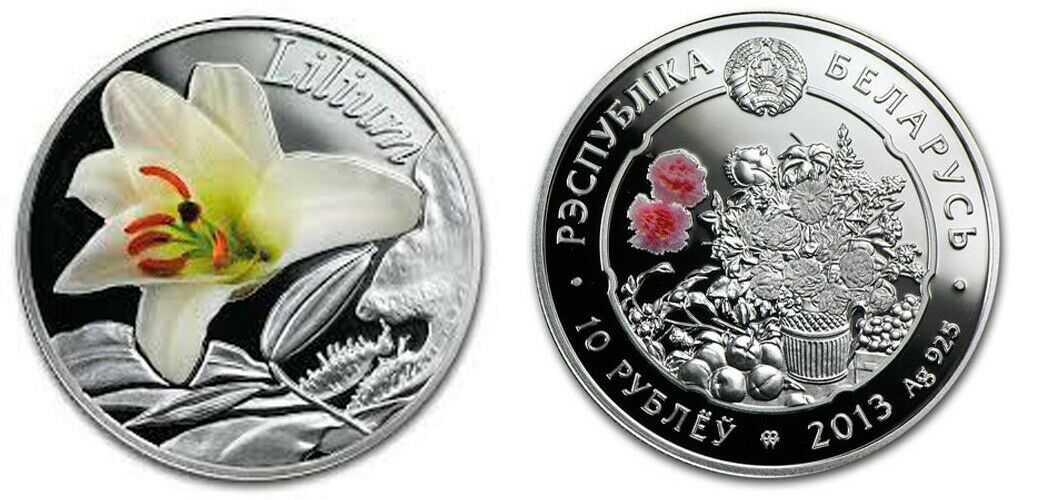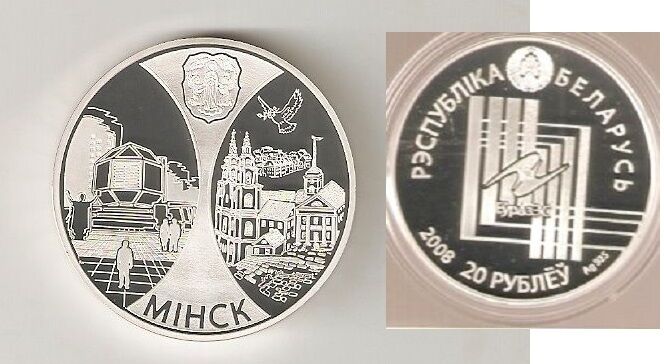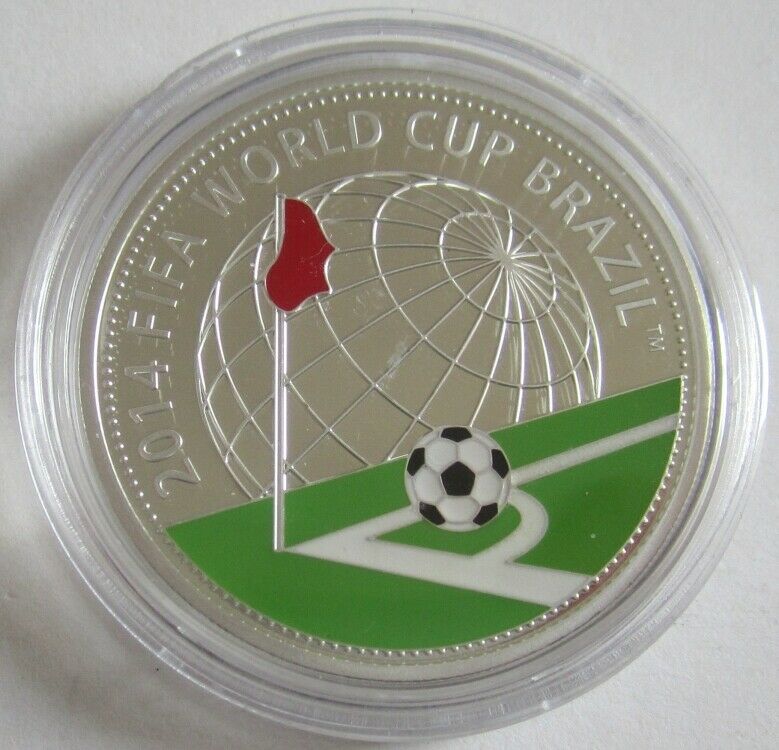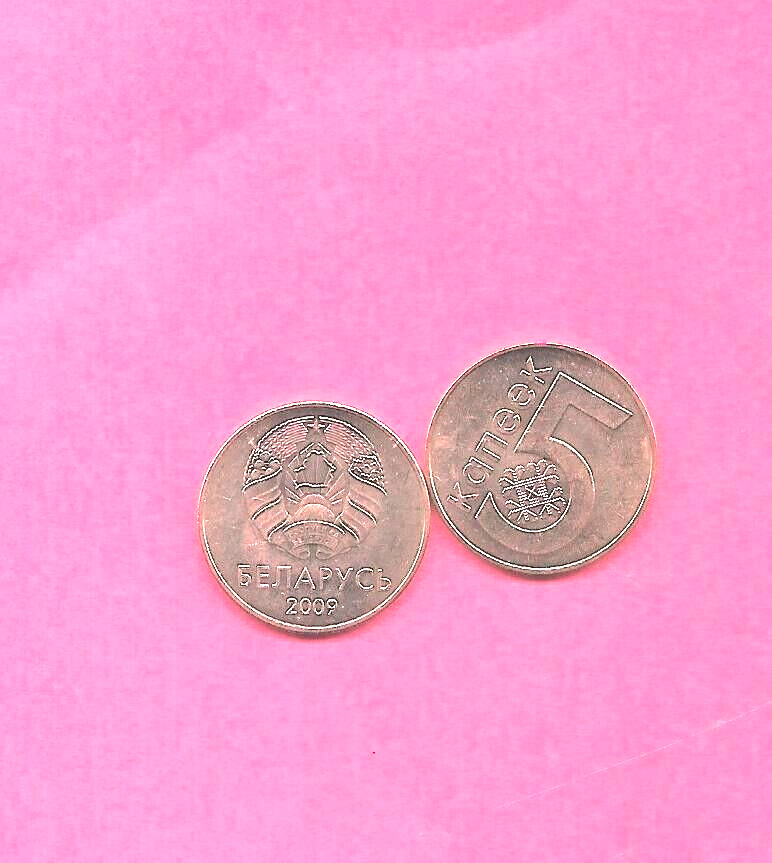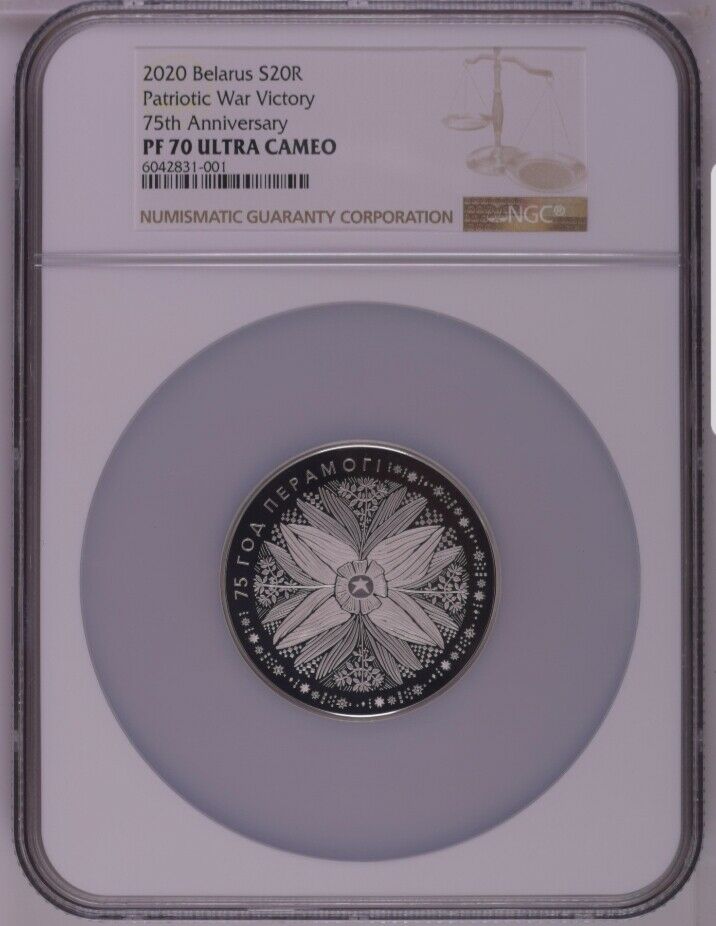-40%
2008 BELARUS Maxim Bagdanovich OLD 1900s POET Proof Silver 10 Ruble Coin i101363
$ 147.2
- Description
- Size Guide
Description
Item:i101363
Authentic Coin of:
Belarus
120th Anniversary of Birth of Maxim Bagdanovich
2011 Proof
Silver 10 Roubles
31mm
(
16.81
grams) 0.925 Silver (0.4999 oz. ASW)
Reference: KM# 349 | Engraver: S. Zaskevich
РЭСПУБЛІКА БЕЛАРУСЬ 10 РУБЛЁЎ 2011, State Coat of Arms of the Republic of Belarus, on the right, ornamental pattern used in the illustrations to Maxim Bagdanovich’s book of poems.
М. БАГДАНОВІЧ 1891-1917, On the left – the relief portrait a classic of the Belarusian literature Maxim Bagdanovich, the ornamental motif of cornflowers.
You are bidding on the exact item pictured, provided with a Certificate of Authenticity and Lifetime Guarantee of Authenticity.
Maksim Adamavič Bahdanovič
(Belarusian: Максім Адамавіч Багдановіч,
IPA:
baɣdaˈnɔvʲit͡ɕ]; Russian: Максим Адамович Богданович,
romanized:
Maksim Adamovich Bogdanovich
; 9 December 1891 – 25 May 1917) was a Belarusian poet, journalist, translator, literary critic and historian of literature. He is considered one of the founders of the modern Belarusian literature.
Bahdanovič was born in Minsk in the family of Adam Bahdanovič, an important Belarusian ethnographer, who through most of his career worked as a bank clerk. Maksim was born in a family apartment at Karakazov House located at Trinity Hill next to the First Parish School. His father was of unlanded peasantry family, while his mother (née Myakota) was of old Belarusian noble family of Kurcz coat of arms that was not adopted in the Russian Empire. Grandfather on his mother side, Apanas Janovich Myakota, was a Russian veteran of the Crimean War who for his military service received a lifelong nobility. Both of Maksim parents graduated pedagogical schools. Later father of Maksim, Adam, was involved with members of the revolutionary anti-tsarist Narodnaya Volya organization.
In 1892 the family moved to Hrodna where Maksim's father received a job at local bank. Soon after the move the future poet's mother, Maria, died of tuberculosis in 1896.
In 1896 Adam Bahdanovič moved with his children to Nizhny Novgorod, Russia. At that time Maksim wrote his first poems in the Belarusian language. In 1902 Bahdanovič attended a gymnasium. During the Revolution of 1905 he was an active participant of the strikes organised by his commilitodes.
In 1907 Nasha Niva came out with Bahdanovič's first published work — the novel
Muzyka
.
In June 1908 the poet's family moved to Yaroslavl'. After finishing school in 1911 Bahdanovič went to Belarus to meet important figures of the Belarusian Renaissance: Vaclau Lastouski, Ivan Luckievič and Anton Luckievich. In the same year he began studying of law at a Yaroslavl' lyceum. During his studies Bahdanovič worked at a newspaper, wrote numerous works of literature and was actively published in both Belarus and Russia.
In the beginning of 1914 his only book of poems,
Vianok
(
A Wreath
), was published in Vilna (today Vilnius).
In the summer of 1916, after absolvation of the lyceum, Maksim Bahdanovič moved to Minsk and worked there at the local guberniya administration.
In February 1917 Bahdanovič went to Crimea to be treated for tuberculosis. The treatment was unsuccessful, and that year he died in Yalta.
The poet's papers were kept at his father's house, but the collection was heavily damaged during the Russian Civil War in 1918.
In 1991–1995 a full collection of Bahdanovich's poetry was published in Belarus.
Nowadays there are museums of the poet open in Minsk (Maksim Bahdanovič Literary Museum), Hrodna and Yaroslavl'. Several streets in major cities of Belarus and Russia are named after him.
The operas Zorka Venera (by Jury Siemianiaka and Ales' Bachyla), and Maksim (by Ihar Palivoda).
Bahdanovich created many examples of social, artistic and philosophical lyrics. He was the first poet to introduce several new lyrical forms to Belarusian literature.
Maksim Bahdanovich was a translator of Paul Verlaine, Heinrich Heine, Alexander Pushkin, Ovid, Horace and other poets into Belarusian and of Janka Kupala, Taras Shevchenko, Ivan Franko into Russian.
In 1916, Maksim Bahdanovič wrote a poem “Pahonia”. The music was written by a Belarusian composer and immigrant activist Mikalay Shchahlou-Kulikovich (Belarusian: Мікалай Шчаглоў-Куліковіч). The song was originally meant to be sung a capella Mikola Ravienski (Belarusian: Мікола Равенскі), Aliaksiej Turankoŭ and Vladimir Mulyavin also wrote their own musical arrangements. In the early 1990s, Shchahlou-Kulikovich’s version was considered as one of the options for the national anthem of the Republic of Belarus. In 2020, under the patronage of Anton Mezhy a choral performance of the anthem was recorded with an orchestra accompaniment.
In 2020, the "Pahonia" anthem and the poem resurged in popularity as one of the symbols of the 2020 Belarusian protests against the Lukashenko regime, along with the white-red-white flag. The anthem was spontaneously performed in several public places: near the Belarusian State Philharmonic, in malls, in the Minsk subway, at the Minsk Kamaroŭski market tarask], and at the Minsk railway station.
Belarus
, officially the
Republic of Belarus
, is a landlocked country in Eastern Europe. It is bordered by Russia to the east and northeast, Ukraine to the south, Poland to the west, and Lithuania and Latvia to the northwest. Belarus covers an area of 207,600 square kilometres (80,200 sq mi), with a population of 9.4 million, and is the thirteenth-largest and the twentieth-most populous country in Europe. The country is administratively divided into seven regions, and is one of the world's most urbanized, with over 40% of its total land area forested. Minsk is the country's capital and largest city.
Until the 20th century, different states at various times controlled the lands of modern-day Belarus, including Kievan Rus', the Principality of Polotsk, the Grand Duchy of Lithuania, the Polish–Lithuanian Commonwealth, and the Russian Empire. In the aftermath of the Russian Revolution in 1917, different states arose competing for legitimacy amidst the Civil War, ultimately ending in the rise of the Byelorussian SSR, which became a founding constituent republic of the Soviet Union in 1922. After the Polish-Soviet War, Belarus lost almost half of its territory to Poland. Much of the borders of Belarus took their modern shape in 1939, when some lands of the Second Polish Republic were reintegrated into it after the Soviet invasion of Poland, and were finalized after World War II. During WWII, military operations devastated Belarus, which lost about a quarter of its population and half of its economic resources. The republic was redeveloped in the post-war years. In 1945, the Byelorussian SSR became a founding member of the United Nations, along with the Soviet Union.
The parliament of the republic proclaimed the sovereignty of Belarus on 27 July 1990, and during the dissolution of the Soviet Union, Belarus declared independence on 25 August 1991. Following the adoption of a new constitution in 1994, Alexander Lukashenko was elected Belarus's first president in the country's first and only free election post-independence, serving as president ever since. Lukashenko's government is widely considered to be authoritarian and human rights groups consider human rights in the country to be poor. Belarus is the only country in Europe officially using the death penalty. Lukashenko continued a number of Soviet-era policies, such as state ownership of large sections of the economy. In 2000, Belarus and Russia signed a treaty for greater cooperation, forming the Union State.
Belarus is a developing country ranking very high in the Human Development Index. It has been a member of the United Nations since its founding; and a member of the CIS, the CSTO, the EAEU, and the Non-Aligned Movement, it has shown no aspirations for joining the European Union but nevertheless maintains a bilateral relationship with the Union, and likewise participates in two EU projects: the Eastern Partnership and the Baku Initiative.
Frequently Asked Questions
Mr. Ilya Zlobin
, world-renowned expert numismatist, enthusiast, author and dealer in authentic ancient Greek, ancient Roman, ancient Byzantine, world coins & more.
Who am I dealing with?
You are dealing with Ilya Zlobin, ancient coin expert, enthusiast, author and dealer with an online store having a selection of over 15,000 items with great positive feedback from verified buyers and over 10 years experience dealing with over 57,000 ancient and world coins and artifacts. Ilya Zlobin is an independent individual who has a passion for coin collecting, research and understanding the importance of the historical context and significance all coins and objects represent. Most others are only concerned with selling you, Ilya Zlobin is most interested in educating you on the subject, and providing the largest selection, most professional presentation and service for the best long-term value for collectors worldwide creating returning patrons sharing in the passion of ancient and world coin collecting for a lifetime.
How long until my order is shipped?
Orders are shipped by the next business day (after receipt of payment) most of the time.
How will I know when the order was shipped?
After your order has shipped, you will be left positive feedback, and that date could be used as a basis of estimating an arrival date. Any tracking number would be found under your 'Purchase history' tab.
USPS First Class mail takes about 3-5 business days to arrive in the U.S. International shipping times cannot be estimated as they vary from country to country.
Standard international mail to many countries
does not
include a tracking number, and can also be slow sometimes.
For a tracking number and signature confirmation, you may want to do Express Mail International Shipping, which costs more, however, is the fastest and most secure. Additionally you may be able to receive your order in as little as 3-5 business days using this method. For Express Mail International, it may be possible to place up to 10-15 items in one package (for the one shipping cost) as it is flat rate envelope, which may be the most cost-effective, secure and fastest way to receive items internationally. Send me a message about this and I can update your invoice should you want this method.
Getting your order to you, quickly and securely is a top priority and is taken seriously here.
Great care is taken in packaging and mailing every item securely and quickly.
Please be aware, I cannot take responsibility for any postal service delivery delays, especially for international packages as it may happen in rare instances.
What is a certificate of authenticity and what guarantees do you give that the item is authentic?
Each of the items sold here, is provided with a Certificate of Authenticity, and a Lifetime Guarantee of Authenticity, issued by a world-renowned numismatic and antique expert that has identified over 57,000 ancient coins and has provided them with the same guarantee. You will be very happy with what you get with the COA; a professional presentation of the coin, with all of the relevant information and a picture of the coin you saw in the listing. Additionally, the coin is inside it's own protective coin flip (holder), with a 2x2 inch description of the coin matching the individual number on the COA.
On the free-market such a presentation alone, can be considered a - value all in itself, and it comes standard with your purchases from me,
FREE.
With every purchase, you are leveraging my many years of experience to get a more complete context and understanding of the piece of history you are getting. Whether your goal is to collect or give the item as a gift, coins presented like this could be more prized and valued higher than items that were not given such care and attention to.
Buy a coin today and own a piece of history, guaranteed.
Is there a money back guarantee?
I offer a 30 day unconditional money back guarantee. I stand behind my coins and would be willing to exchange your order for either store credit towards other coins, or refund, minus shipping expenses, within 30 days from the receipt of your order. My goal is to have the returning customers for a lifetime, and I am so sure in my coins, their authenticity, numismatic value and beauty, I can offer such a guarantee.
When should I leave feedback?
Once you receive your order, please leave a positive feedback. Please don't leave any negative feedbacks, as it happens sometimes that people rush to leave feedback before letting sufficient time for their order to arrive. Also, if you sent an email, make sure to check for my reply in your messages before claiming that you didn't receive a response. The matter of fact is that any issues can be resolved, as reputation is most important to me. My goal is to provide superior products and quality of service.
How and where do I learn more about collecting ancient coins?
Visit the "
Guide on How to Use My Store
" for on an overview about using my store, with additional information and links to all other parts of my store which may include educational information on topics you are looking for.



